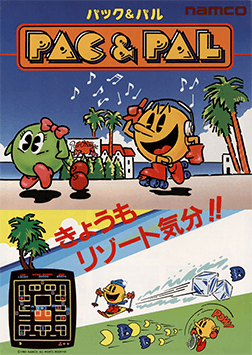Pac & Pal
| Pac & Pal | |
|---|---|
|
Japanese arcade flyer of Pac & Pal. | |
| Developer(s) | Namco |
| Publisher(s) | Namco |
| Composer(s) | Yuriko Keino |
| Series | Pac-Man |
| Platform(s) | Arcade |
| Release date(s) |
|
| Genre(s) | Maze |
| Mode(s) | Up to 2 players, alternating turns |
| Cabinet | Upright and cocktail |
| Arcade system | Namco Super Pac-Man |
| CPU | 2x Motorola M6809 @ 1.536 MHz |
| Sound | 1x Namco WSG @ 1.536 MHz |
| Display | Vertical orientation, Raster, 224 x 288 resolution |
Pac & Pal (Japanese: パック&パル Hepburn: Pakku ando Paru) is an arcade game that was released by Namco on July 30, 1983 exclusively in Japan. It runs on Namco Super Pac-Man hardware, and the object of the game is for Pac-Man to eat all the items before he is caught by the ghosts. Most of the items are fruits from the original Pac-Man game, with a few new additions. Their value varies, starting with cherries at 50 points, and ending with keys from 700 to 5000 points. The items had to first be unlocked by turning over cards distributed around the maze (instead of eating keys like in Super Pac-Man). Very few cabinets still exist today, and this is possibly one of the rarest Pac-Man titles to find in playable format outside Japan.
"Pal" character
Introduced in this game is an exclusive character: Miru (ミル), the "Pal" of the title. She is a small green female ghost (denoted by her hair bow), that looks like a gooseberry with legs. When an item is unlocked, she will wander around, giving Pac-Man some time to try to reach the item. After some time, she will take it into the ghost house, where it will be lost forever. This might help in clearing the round, however, and if she brings the last one there, it automatically finishes the round. Due to the ability of using this advantage, this may be the reason why she is known as "Pal". She is not affected by the other ghosts. In order to get the maximum amount of points from the items on each round (and a perfect bonus at the end), Pac-Man must either eat them first or intercept them from Miru.
An alternate version of this game features Chomp-Chomp, Pac-Man's dog from the animated cartoon series, in place of Miru, and the game's name is changed to Pac-Man & Chomp-Chomp.
New feature
Another new feature for a Pac-Man game (besides Miru) is a shooting capability. Instead of having energizers, two of the edible items are the round's particular bonus item, which are displayed at the bottom of the screen after each new round is reached. The first two are the Galaxian flagship. Later items include: a red car from Rally-X, a trumpet, a snowman, and even other Pac-Men. When Pac-Man eats these, instead of the ghosts turning blue, he himself becomes blue, and momentarily has the power to spit a ray, smoke, musical notes, freezing rays and miniaturized versions of himself at the ghosts (who turn purple and sometimes blue, depending on the item used to stun them). This stuns them and yields the familiar point value of 200, 400, 800, and 1600 for each ghost shot. While ghosts are stunned, Pac-Man can pass right through them. If the stunning effect wears off before the ray-shooting ability wears off, Pac-Man can shoot the ghost again for 1600 more points. The point value won't reset if Pac-Man eats the other bonus item before the effect wears off.
The third round and every fourth round thereafter is a bonus round, in which the maze only contains cards that will yield an increasing number of points when turned over. When Pac-Man turns over the card with Miru under it, players receive a bonus multiplying twice as their bonus score when the round is over. The card with Blinky under it causes the round to be over. Pac-Man will not lose a life hence the notability of having no ghosts in the round.
Each round also has a simple musical background, unlike in any of the previous Pac-Man games.
Rerelease
The game was included in the 2007 Wii compilation Namco Museum Remix as well as its 2010 update (also on Wii), Namco Museum Megamix.
External links
- Pac & Pal at the Killer List of Videogames
- Pac & Pal at the Arcade History database
- Japanese arcade flyer scans
